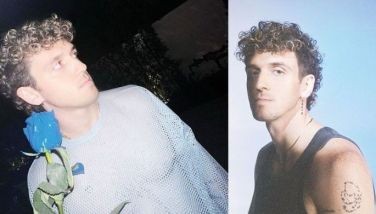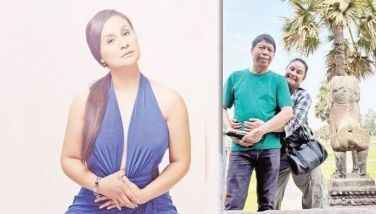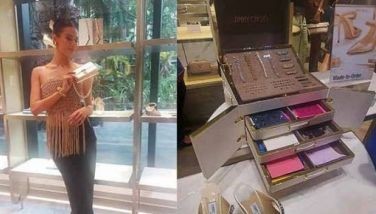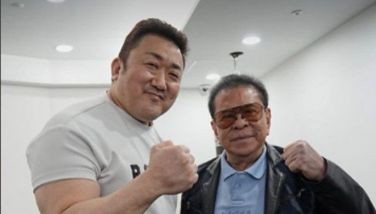Reviewing the Balangay's role in nation building
MANILA, Philippines -When filmmaker Laurice Guillen called us last weekend to ride the following day on a replica of an ancient vessel, we didn’t exactly know what we were in for. But it sounded exciting that we cancelled all appointments to make the trip.
What actually transpired was an unforgettable Voyage of the Balangay as the trip has come to be known, on the exact copy of a boat used by our forebears thousands of years before Magellan even set foot on Homonhon in Samar. It is significant that the word balangay gave rise to our basic unit of government, the barangay.
The trip opened to us still another side of Laurice unknown to those outside show business. For the past six years, Laurice, who in 2005 was proclaimed Most Outstanding Butuanon, was asked to chair the NGO Butuan Global Forum (BGF) of prominent residents reaching out to kababayan worldwide in support of the province’s focus on environment, historical legacy, tourism and conservation, and enterprise development in Butuanon communities.
 Laurice with Art Valdez, Jody Navarra, Toto Calo and Isabel Torre
Laurice with Art Valdez, Jody Navarra, Toto Calo and Isabel Torre In the ’70s, the first of several boats carbon dated to around 320 AD was excavated in Butuan which would spur the idea of building duplicates. Jorge “Jody” Navarra, project committee co-chair of building the Butuan Balangay Boat and BGF secretary, overseered the construction. Our aim is to highlight Philippine maritime history and skills long before the coming of foreign colonizers, says Navarra.
Without blueprints, employing knowledge handed down from generations, the Sama Badjaos used ancient boat-building techniques and tools on these wooden boats with carved-planks utilizing dowels without nails, the cabo negro grass rope, sealing tree resin, and hard woods like red lauan, molave and yakal, relates Daniel “Toto” Calo, Butuan businessman and volunteer Voyage officer who claims that nine such old boats have been found in Butuan, but nowhere else around the country and Southeast Asia.
 Bodie and Djanin Cruz with Ina Feleo
Bodie and Djanin Cruz with Ina Feleo Three balangay boats were built — the Diwata ng Lahi, Masawa hong Butuan popularly referred to as the Butuan Balangay and Sama Tawi-Tawi, a support vessel equipped with a marine engine, radio and toilet/bath facilities. The Diwata sailed from Sept. 2009 from Manila arriving in Butuan in Nov. 2009. The biggest, the Butuan Balangay was built with funds raised by BGF which partnered with Kaya ng Pinoy NGO led by Arturo Valdez, leader of the First Philippine Mt. Everest climb in 2006, and the three all-female team in 2007.
In Aug. 10, 2010, with a crew of 40 consisting of all the Mt. Everest summiteers, Philippine Navy, Coast Guard, Davao mountaineers, Badjaos and other volunteers, the Butuan Balangay skippered by Valdez left for a 15 month journey visiting seven countries in Southeast Asia and 120 ports of call. Its aim was to retrace the routes the ancient Filipinos took in their search for trade and adventure. It came back to the CCP grounds in December 2010.
 Everest Summiteers formed part of the crew
Everest Summiteers formed part of the crew This was the vessel we boarded last weekend where it dropped us off an hour away at Sangley Point Naval Base before proceeding on its journey home to Butuan. Where it would go next, would be determined in Butuan. The hour-long trip was also Laurice’s and her daughter Ina Feleo’s first. Guests on the boat were Nestor Torre from Inquirer, Behn Cervantes from Business World, Nestor’s 90-year-old mom Isabel whose husband was a sailor, Nestor’s nephew and niece, and Tirso Cruz’s children Bodie and Djanin. At some other point on Butuan Balangay’s 15-month journey, the 83-year-old Fidel Ramos managed to board and sail on it. But to date Isabel Torre is its oldest passenger. We barely had time to admire the sturdiness of the vessel, and to chat with skipper Art Valdez on their Everest climb and why it had the same purpose as the Balangay Voyage when the winds brought us quickly to Sangley to disembark.
When Art was reminiscing of the group’s conquest of Everest, he recalled when as past president of the National Mountaineering Federation, he had proposed in 2003 that a climb of Mt. Everest would be a good way of instilling pride in the Filipino. This was a time when the image of Pinoys was bedraggled and torn and needed reorientation. Having had no alpine tradition, Art sought training for the group of nine for three years abroad, and amazed the world with their success at reaching the peak in 2006.
The second year climb was more treacherous, from Tibet north up summit and down the south called a traverse route, he says. “Only 10 people in the world, all Caucasians on different years, had been successful. And three Filipino women, Noelle Wenceslao, Carina Dayondon and Janet Belarmino, members of the Coast Guard. We didn’t just climb Everest. We took Everest by storm,” Art proudly shares.
 From left: Nestor Torre, Behn Cervantes, Isabel and Laurice
From left: Nestor Torre, Behn Cervantes, Isabel and Laurice Art tells his story with passion, even as we know he has done this countless times, in school auditoriums explaining that climbing was not the be all and end all for material gain of which there was none. It was a matter of enlisting national pride, of instilling in each and every Filipino that sense of nationhood, the lack of which F. Sionil Jose in his own campaign through writing has grieved about often enough. We felt like those students, not understanding, asking stupid questions. Yet Art was patient enough. He understood that the sense of nation could not be gained in one lecture. “Not in one generation,” he utters. “What is important is that we have planted the seed.”
What was next for team Everest? The Voyage of the Balangay was stirring up feelings of national pride in our heritage. What better than to continue the momentum experienced in Everest by championing the BGF advocacy through the Kaya ng Pinoy NGO set up with the mountaineers. They now sought to regain the reputation of the Filipino as champion seafarers.
 Interior showing sleeping and eating area
Interior showing sleeping and eating area “We are trying to highlight again our affinity to the sea by riding in the boat, using it the way it was, to help our people realize again who we are. It is already in us that we are great seafarers. The South China Sea, Sulu seas, the waters of Thailand, Java, and Celebes were not there to divide us as is taught by our colonizers. The balangay is the link that unified us with them, and that’s how the whole of Southeast Asia sees us now,” explains Art.
With more and more hammering away at our national pride from all directions, there is no way we will not attain this at all. We agree with Art that despite all the centuries under various masters from whom we had gained religions, educational methods, modes of government all alien to our systems that were already in place long before Magellan, the Filipino will re-discover himself and be the nation our grandchildren will again be proud of.
(E-mail me at [email protected].)
- Latest
- Trending
























 Exclusive
Exclusive







